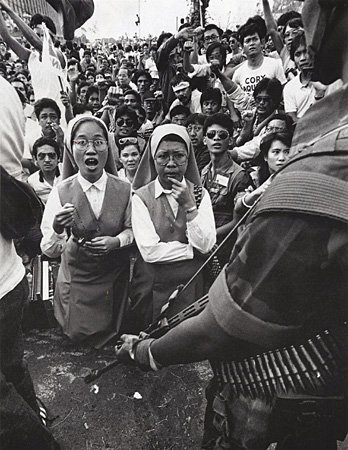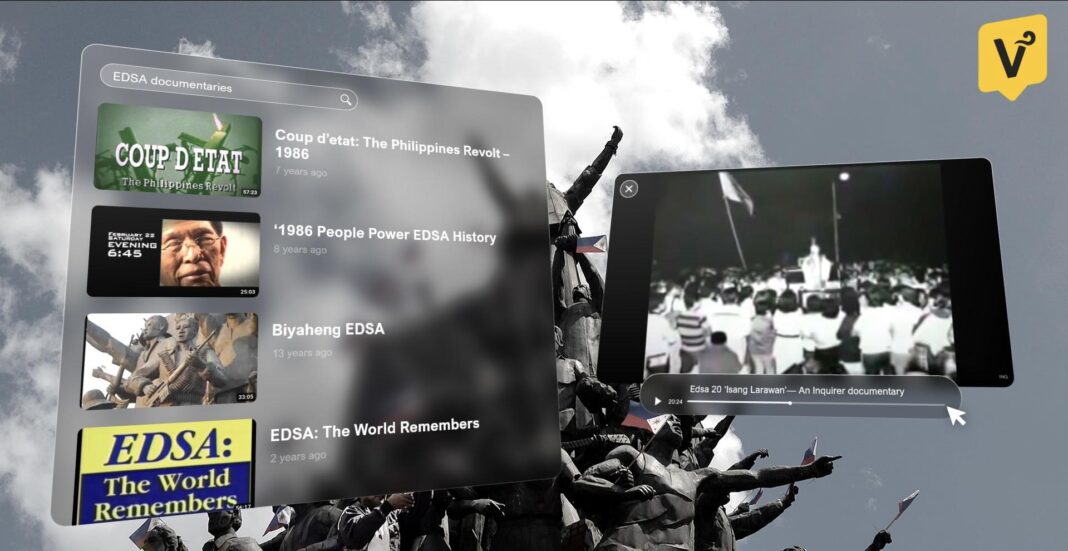IT HAS BEEN 38 years since millions of Filipinos trooped to the vast stretch of Epifanio de los Santos Avenue (EDSA) and ignited a peaceful revolt against the dictatorial rule of Ferdinand Marcos Sr., whose family was sent packing from the Palace shortly after.
Today, the consequential event in Philippine history continues to be remembered through various works in media–from books such as “People Power: An Eyewitness History,” to films like “Dekada ‘70.”
The Varsitarian picked five documentaries chronicling the events of the EDSA People Power Revolution that Filipinos could watch and learn from as they remember the historical uprising today, Feb. 25.
‘EDSA 20: Isang Larawan’
Released in 2006, the 50-minute documentary “Isang Larawan” was produced by the Philippine Daily Inquirer initially to air on TV5, in honor of the 20th anniversary of the EDSA Revolution that year.
The documentary features “voices that had previously never been heard from before,” by conducting interviews with Catholic nuns Teresita Burias and Porfiria Ocariza, who were part of the congregation Daughters of St. Paul.
Srs. Burias and Ocariza were the subjects of Pete Reyes’s famous photograph titled “Two Nuns of EDSA,” where they were shown kneeling in front of military troops as war tanks arrived at EDSA.

“EDSA 20: Isang Larawan” can be viewed on the Philippine Daily Inquirer’s official YouTube account.
‘Coup d’etat: The Philippines Revolt’
“Coup d’etat: The Philippines Revolt,” a documentary written and produced by Australian journalist Peter Couchman in August 1986, depicts the four crucial days leading up to the uprising.
Its in-depth narration offers various insights into the revolution against the Marcos Sr. rule, which it describes as a “unique military revolt that was won not by military force, but by the church and ordinary people.”
The documentary gives a glimpse of the perspectives of key players behind the revolt, like Cardinal Jaime Sin, Juan Ponce Enrile, Gringo Honasan, and Corazon Aquino.
The 57-minute documentary can be streamed on YouTube.
‘1986 People Power EDSA History’
Presenting a concise timeline of events that transpired from Feb. 22 to 25, “1986 People Power EDSA History” is a 25-minute long deep-dive into the military aspect of the uprising.
Produced by the Department of National Defense in 2013, the documentary features interviews with several military personalities during the time of the revolt, such as former defense secretary Juan Ponce Enrile, Reform the Armed Forces Movement leader Rex Robles, as well as Fidel Ramos’s son-in-law and military aide Alex Sembrano.
The documentary can also be viewed on YouTube.
‘Biyaheng EDSA’
First aired in February 2006, two decades after the popular revolt, “Biyaheng EDSA” tackles the changes and challenges in the Philippines that the thoroughfare has served witness to.
Produced by GMA News and Public Affairs for their docuseries “I-Witness,” the documentary features veteran broadcast journalist Howie Severino as he walks along the modern-day EDSA.
Throughout the 33-minute documentary, Severino uncovers the issues that mark the name “EDSA” today, such as traffic congestion and homelessness.
“Biyaheng EDSA” can be accessed on YouTube.
‘EDSA: The World Remembers’
The 1995 documentary “EDSA: The World Remembers” lays out the insights of various world leaders about the February 1986 uprising, dubbed by the late Corazon Aquino as the “Filipino people’s best gift to the world.”
Directed by Maria Montelibano under MVM Productions, it includes interviews and statements made by key officials in foreign governments, including François Mitterrand, former president of France, who described the EDSA People Power Revolution as “extraordinary” for its peaceful victory.
“EDSA: The World Remembers” can be accessed through historian Xiao Chua’s YouTube account.













